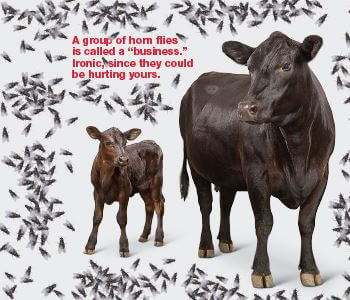Business.' Ironic, Since They Could Be Hurting Yours
Jun 03, 2020

We all love summer. The sunshine and warm temperatures drive us to spend an abundant amount of time outdoors. However, with the good comes the bad and we find ourselves constantly swatting pesky flies. Now imagine up to 4,000 Horn flies biting and taking a blood meal anywhere from 20-40 times per day! It makes me cringe just thinking about it, but unfortunately that’s the ugly truth for pasture cattle that go without fly control for the summer.
Horn flies are a different breed than most face or stable flies. They are smaller in size, measuring approximately four millimeters long and spend their lifetime on a single host. Horn flies lay eggs in fresh manure, where they eventually emerge into adult flies. They can be found on the backs of cattle, sometimes up to 4,000 on each host. They tend to make their ways down the sides and on the belly during the day to avoid the sun and extreme temperatures, all while continuing to bite for a blood meal 20-40 times per day. Its estimated that during extreme infestation, a cow can lose a half a pound of blood per day. Often as we drive by pastures, cattle seem to be huddled in the corner stomping and swinging their heads and tails in an attempt to get rid of flies. By doing this, cattle not only exert an ample amount of energy to replenish their blood supply but are also not out grazing. Over time, this will affect grazing patterns, lactation (continuous fly bites on exposed teets may cause mastitis) and overall growth. A University of Nebraska study showed that pairs on a fly control program weaned 10-15-pound heavier calf in the fall, while a different study showed improved weaning weights up to 25pounds and could save up to $5.50 per pair for a summer feeding season.
Controlling flies can become labor intensive and expensive. Sprays need to be done on a regular basis and may be difficult to accomplish in a pasture setting. Therefore, Purina recommends using Altosid IGR, a Methoprene product that is fed through the mineral, and can be used in either bags or tubs. Altosid is a feed-through product that goes directly into the manure, where the horn flies lay eggs. Methoprene prevents the pupae from hatching into an adult fly and therefore spends its whole life in the manure. Horn flies are unable to build up resistance to Altosid because they never reach the adult stage. While the optimal time to start Altosid is 30 days before fly season and continued use 30 days after a killing freeze, starting now would still provide relief as the summer goes on.
Overall, a good fly control program can minimize fly populations while decreasing stress on your cattle and increasing your operation's potential bottom line. If you have any questions or would like to discuss a fly mineral program, please don’t hesitate to contact us. We would be happy to help.

McKenzie Smith
Purina Animal Nutrition
605-448-2231
MAChambers@landolakes.com